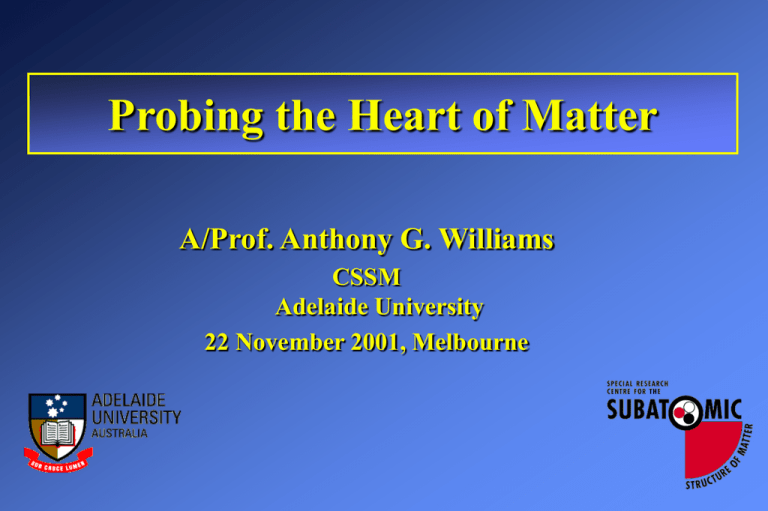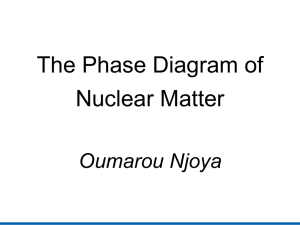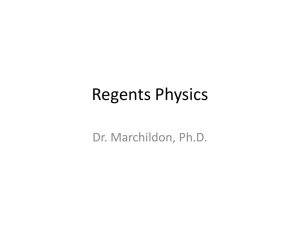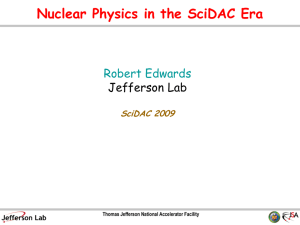AGW_boas_talk
advertisement

Probing the Heart of Matter A/Prof. Anthony G. Williams CSSM Adelaide University 22 November 2001, Melbourne Outline of Talk • • • • • • • • • Introduction and Context Special Research Centre for the Subatomic Structure of Matter (CSSM) The Standard Model of Particle Physics Quantum Chromodynamics (QCD) Quarks and Gluons and the Origin of 98% of the Mass of Tangible Matter Lattice Gauge Theory and Lattice QCD Orion Supercomputer Centre for High-Performance Computing and Applications (CHPCA) Conclusions and Outlook Introduction and Context • • • • • • • Strongly interacting matter makes up almost the entire mass of the tangible universe, from the protons and neutrons in the nuclei of atoms and molecules to neutron stars. The strong interaction fuels the sun and stars and determines which nuclei are stable and hence which elements can exist. The underlying theory of the strong interaction is called quantum chromodynamics (QCD) and has quarks (like electrons) and gluons (like photons but self-interacting) as its fundamental constituents. Quarks and gluons are bound so strongly together that they can never appear as free particles. This is called confinement. When probed at increasingly higher energies the interaction between them becomes progressively weaker. This is called asymptotic freedom. The quarks in your body represent only about 2% of your mass with the rest of your mass being generated by the strong interaction itself. The world's fastest supercomputers are being used to improve our understanding of the strong interaction and the unusual properties of quarks and gluons. Concepts •Strongly interacting matter is referred to as hadronic matter and strongly interacting particles are called hadrons, e.g., protons, neutrons, and pions are all hadrons •Hadrons with 1/2 integer spin (e.g., 1/2, 3/2, 5/2,…) are fermions and are called baryons. Protons and neutrons are baryons. •Hadrons with integer spin (e.g., 0, 1, 2, …) are bosons and are called mesons. The pion is a meson. •Nuclei consist of protons and neutrons bound together by the strong interaction. •The elements and hence all of chemistry is determined by which nuclei are stable. Boson = Bose-Einstein statistics Fermion = Fermi-Dirac statistics Scales • Typical atomic size is 10-10 m = 1 Angstrom • Typical nuclear sizes are 10-14 m = 10 fermi • 1 fermi = 1 fm = 10-15 m • Proton radius is 0.8 fm,i.e., approximately 1 fm • No substructure of electrons or quarks has ever been observed at resolutions down to approximately 1/100,000,000 Angstroms = 10-18 m. • At the present time we assume that electrons and quarks are elementary particles. Atomic Structure • Warning: Sketch not to scale! • If the protons and neutrons in this nucleus are 10cm across then • the nucleus is about 100cm across, • the electrons and quarks are less than 0.1mm across, • and the atom is 10km across! Fundamental Forces There are four fundamental forces which are believed to give rise to all observed physical phenomena. • Gravity: holds us to the earth, binds stars, solar systems, galaxies, etc. • Electromagnetic: e.m. radiation, chemistry hence biology, touch, electronics, etc. • Weak: radioactivity, neutrino physics of supernovae, etc. • Strong: all familiar matter, nuclear energy, powers sun and stars, etc. Special Research Centre for the Subatomic Structure of Matter (CSSM) • The CSSM is a Special Research Centre of the Australian Research Council (ARC) funded for nine years (since 1997) to carry out theoretical research in subatomic physics. • Mission: • - Make major advances in the understanding of the structure of hadronic matter - Cross fertilization enhances opportunities for breakthroughs in understanding - Pursue lattice, models, phenomenology, and strong links to experimental results - Develop strong international links, exchanges Personnel: - High level postgraduate and postdoctoral training - Interact with best researchers in a stimulating atmosphere • Service: - LANL Archive for Australia - Workshop program (support external students and affiliate staff) - Stimulate school students to science (brochures, school visits) - Physics Guru, Public Lectures, Newspapers, radio, Television CSSM: Current Academic Staff • • • • • • • • • • • Professor Anthony Thomas (Director) A/Prof. Anthony Williams (Deputy Director) Dr. P. Coddington Dr. Alex Kalloniatis (Australian Research Fellow) Dr. Derek Leinweber Dr. Andreas Schreiber (Australian Research Fellow) Dr. Ingo Bojak Dr. Xin-Heng Guo Dr. Ayse Kizilersü Dr. Vadim Guzey Dr. Martin Oettel (joint appointment Alexander von Humbolt Stiftung/Foundation & CSSM) • Dr. Jianbo Zhang Postgraduate Students • • • • • • • Sundance Bilson-Thompson (Ph.D.). Supervisors: D.B. Leinweber & A.G. Williams Francois Bissey (Ph.D.). Cotutelle (U. Blaise Pascal) & A.W. Thomas. Frederic Bonnet (Ph.D.). Supervisors: D.B. Leinweber & A.G. Williams. Patrick Bowman (Ph.D.). Supervisors: D.B. Leinweber & A.G. Williams; position at Florida State Univ. Shane Braendler (Ph.D.). Supervisor: A.W. Thomas Will Detmold (Ph.D.). Supervisors: A. Bender & A.W. Thomas Emily Hackett-Jones (M.Sc.). Supervisors: D.B. Leinweber & A.W. Thomas • • • • • • • Waseem Kamleh (Ph.D.). Supervisor: A.G. Williams Daniel Kusterer (M.Sc. BadenWuerttemberg/S.A. Exchange Program) - Supervisor: D.B. Leinweber Olivier Leitner (Ph.D.). Cotutelle (U. Blaise Pascal) & A.W. Thomas Tom Sizer (Ph.D.). Supervisor: A.G. Williams Stewart Wright (Ph.D.). Supervisors: D.B. Leinweber & A.W. Thomas; position at Liverpool, UK. Ross Young (Ph.D.). Supervisors: D.B. Leinweber & A.W. Thomas James Zanotti (Ph.D.). Supervisors: D.B. Leinweber & A.G. Williams International Collaborative Agreements Abdus Salam International Centre for Theoretical Physics - Italy Argonne National Laboratory - USA Bonn University - Germany Chinese Academy of Sciences (Beijing) - China Commissariat à l'Energie Atomique - France European Centre for Theoretical Studies in Nuclear Physics and Related Areas (Trento) - Europe Indiana University (Bloomington) - USA Institute for Nuclear Theory, University of Washington (Seattle) - USA Instituto De Fisica Teòrica (IFT-UNESP) - Brazil Joint Institute for Nuclear Research (JINR - Dubna) - Russia Jülich (FZ) - Germany International Collaborative Agreements (cont.) MESON (Medium Energy Science Open Network) involving IUCF Indiana; Yonsei, Korea; RCNP Osaka; KVI Groningen; IMP Lanzhou; TSL Uppsala; NAC Cape Town; SAHA Calcutta; FZ Jülich; CIAE Beijing Osaka University - Japan Computational Science and Information Technology (CSIT, Florida) USA Svedberg Laboratory - Sweden Thomas Jefferson National Accelerator Facility (Newport News) - USA Technical University of Munich - Germany TRIUMF (Vancouver) - Canada Université Blaise Pascal - France University of Tübingen - Germany CSSM Workshops/Conferences 2000 • 3rd International Symposium on Symmetries in Subatomic Physics March Total Number of Participants: 85 Overseas Participants: 45 Interstate Participants: 12 Local Participants: 28 • International Conference on Quark Nuclear Physics - February Total Number of Participants: 109 Overseas Participants: 75 Interstate Participants: 1 Local Participants: 33 • HallD Workshop - February Total Number of Participants: 45 Overseas Participants: 24 Interstate Participants: Nil Local Participants: 21 CSSM Workshops/Conferences 2001 • Lattice Hadron Physics Workshop - July Total Number of Participants: 42 Overseas Participants: 26 Interstate Participants: 1 Local Participants: 15 • Hamiltonian Lattice Gauge Theories Workshop - April Total Number of Participants: 19 Overseas Participants: Nil Interstate Participants: 4 Local Participants: 15 • Leptonic Scattering Workshop - March Total Number of Participants: 64 Overseas Participants: 35 Local Participants: 29 Visitor Program 2001 • • • • • • • • • • • Dr. P. Bowman, Florida, USA Dr. A. Chian, Sao Paolo, Brazil Dr. M. Chaichian, Helsinki Dr. G. Dunne, Connecticut Dr. Y. Hoshino, Kushiro, Japan Dr. C.-S. Huang, Beijing, China Prof. A. Ioannides, RIKEN, Japan Dr. S. Krewald, Jueilich, Germany Dr. R. Landau, Oregon, USA Dr. D. Lu, Zhejiang, China Prof. W.-X. Ma, Beijing, China • • • • • • • • • • • Dr. K. Maltman, York, Canada Dr. S. Sharpe, Seattle, USA Dr. A. Signal, Massey, NZ Dr. D. Sinclair, Argonne, USA Prof. J. Speth, Juelich, Germany Dr. P. Tandy, Ohio, USA Dr. G. Valencia, Iowa, USA Prof. M. Veltman, Utrecht Dr. J. Vergados, Ionnina, Greece Dr. L. von Smekal, Erlangen Dr. M. Weyrauch, Bundesanstalt, Germany Future Workshops • Joint Workshop with JHF, March 2002 • The Structure of the Nucleon (Joint with ECT* in Trento), September 2002 • NUPP Summer School, February 2003 • 2nd Lattice Workshop, Cairns, June/July(?) 2003 The Standard Model Let us review some aspects of the standard model briefly before beginning to focus on QCD itself. The Standard Model: Fermions • In addition to the 6 known flavors of quarks they come in 3 “colours”: red, blue, and green • “Lepton” comes from the Greek for small mass • Leptons do not carry color charge, i.e., they do not feel the strong force The Standard Model: Bosons • The very massive W-, W+, and Z0 bosons mediate the weak interaction, which as a result is very short range • The massless photon mediates the long-range e.m. interactions • Gluons carry color and mediate the strong interaction The Standard Model: Forces • Gravitons are thought to mediate the gravitational force but have not yet been seen • Gravitational waves are to gravitons what e.m. radiation is to photons • Above we see the relative strengths and relative ranges of the four fundamental forces Standard Model: Sample Processes Standard model processes and interactions: • neutron beta decay (neutrons are only stable in nuclei which is just as well!) - imagine the universe if this was not so ... • electron-positron annihilation to meson-antimeson pair • proton-proton collision producing two Z0 bosons and other hadrons • • • • Early Univers e Free quarks and gluons existed until about 10-5 seconds atoms formed at about 300,000 years stars formed at about 1 billion years solar systems and life at about 12 billion years Neutron Stars • Different phases of hadronic matter can co-exist within a neutron star. • For this sample neutron star, it is expected that quark matter becomes a stable phase 1km beneath the surface. • In the central core quark matter is dominant. Neutron Star: Phase vs Density • • Protons and neutrons are collectively referred to as nucleons Ordinary nuclear matter density is approximately 0.17 nucleons/fm3 Quantum Chromodynamics (QCD) All hadrons are color-singlet (“white”): • Baryons contain three quarks (red + blue + green) - Different baryons arise from the three quarks having different flavor combinations. • Mesons contain colour + anticolour combinations of quark and antiquark •A red quark emitting a pairs (red + anti-red, green + antired-anti-blue gluon to green, blue + anti-blue) - Different leave a blue quark. mesons arise from different flavor •The quark flavor (i.e., combinations of the pair. u,d,s,c,b,or t) does not • Each flavor of quark cycles through change during this the three colors by exchanging process, since gluons gluons with the other quarks or anticarry no flavor. quark. QCD: Nuclear Forces All hadrons are color-singlet (neutral or colorless or “white”) combinations of quarks (3 quarks for baryons or quark-antiquark pair for mesons). But just as electrically neutral atoms interact by van der Waals forces, so can color neutral particles. This has very important consequences … the strong nuclear force. Two protons attract despite their e.m. repulsion ………… stable nucleus … leads to …. … and hence to atoms, molecules, chemistry, and all of biology. QCD: Baryons and Antibaryons • Baryons are color-singlet combinations of three quarks. • Anti-baryons are colorsinglet combinations of three antiquarks. QCD: Mesons • Mesons are made up of a quark - antiquark pair with equal and opposite color charges giving a color-singlet. Confinement • The strong force between two quarks arises from the exchange of gluons. • There is also a strong force between two gluons - since they carry color themselves they can interact with each other. This is not the case for photons in QED since they carry no electric charge. • The force between two quarks is constant, i.e., independent of their separation. This corresponds to a linearly rising potential between them, which is referred to as a “string tension”. • This force between colored objects is equivalent to a wieight of approximately 10 tons! - This is why no free quarks or gluons are ever seen. QCD has the property of CONFINEMENT. String Breaking: Quark - Anti-quark Pairs “Gluons” are well-named since they lead to the confinement of color particles - no free colored objects have EVER been seen in nature. What happens when we try to pull apart two colored objects by pumping more and more energy into the system, e.g., through energetic collisions at a particle accelerator? •When the energy put in is large enough to make a quark - anti-quark pair, then a meson can be created and the string is “broken”. •Confinement survives however as no free color particles are produced. Asymptotic Freedom • • • • ASYMPTOTIC FREEDOM • In quantum electrodynamics (QED) the fine structure constant is 1/137. In QCD the coupling “runs” by decreasing with increasing energy scale, i.e., at short distances. At the energy scale of the Z0 mass the strong coupling constant has decreased to a value s 0.12. Quarks and gluons appear almost free at high energies. At low energies s 1, i.e., the coupling is very STRONG and perturbation theory fails.. Strong Coupling Constant at Z Mass • At the energy scale of the Z0 mass the strong coupling constant has decreased to s 0.12. • This has been confirmed in a variety of different experiments with a remarkable degree of consistency. QCD Produces 98% of Your Mass •Proton mass is 938 MeV = 0.938 GeV. Where does the rest of the hadron mass come from? •Up and down quark masses are approximately 3 and 6 MeV respectively. •The interactions in the low-energy (long-distance) are so strong (i.e., non-perturbative) that they induce a mass in the quarks of approximately 300 MeV. This is referred to as “dynamical mass generation”. This is how three quarks in a bound state can have a mass exceeding their naïve sum. •The fact that the up and down quarks are so light and because of this mass-generation, Goldstone’s theorem states that there will be nearly massless Goldstone bosons associated with the spontaneous breaking of this symmetry - these Goldstone bosons are the pions which are anomalously light mesons. This is the basis of what is called “chiral symmetry” and “dynamical chiral symmetry breaking”. Lattice Gauge Theory • Physicists at the CSSM and elsewhere use the techniques of lattice gauge theory to put all of four-dimensional space-time on a grid or lattice. • We formulate the gauge field theory (e.g., QED, QCD, etc.) on this discrete lattice with finite-difference techniques. This is done in Euclidean space-time for numerical reasons. We use methods adapted from statistical mechanics to study the physical properties of the theory from the confining to the asymptotically free regimes. • We use this to study and model subatomic particles and their interactions. It is VERY computationally expensive to do this Teraflop-years of computer time are needed. • More accurate results need a finer lattice with larger space-time volumes. This is what makes it computationally costly. Lattice QCD Depiction of electron scattering from quark through a virtual photon exchange in a background gluon field. Lattice QCD does weighted averages over gauge field configurations to obtain physical quantities of interest. Lattice QCD: Gluon Configurations •Typical gluon field configuration used in lattice calculations, (3-dim slice of 4-dim lattice showing action density, where red depicts highest). •The estimate of the integral over gluon fields does a weighted average over hundreds of these. Fluctuations in the QCD vacuum. High-Performance Computing • Traditionally supercomputers were very expensive, contained purpose-built hardware, and were obsolete within 5 years. • Most modern high-performance computing uses cost-effective clusters of mass-produced commodity off-the-shelf (COTS) hardware, rather than expensive proprietary hardware. • These clusters of workstations or PC’s are connected either by commodity Fast Ethernet or Gigabit switched networking or by (more expensive) special ultrafast, low-latency networks for clustering (e.g., Myrinet, ServerNet, GigaNet, SCI, etc). • Clusters are flexible in their design and easy to build and upgrade - e.g., add more nodes; upgrade some or all of the nodes; upgrade some or all of the networking. • Can get an order of magnitude better price/performance ratio! Top 500 Supercomputers • Clusters of PCs or Unix workstations have become incredibly popular in the last few years -- ranging from a few networked PCs to around 1000 Compaq Alpha workstations. • The unit used to measure the performance of computers is the “flop”, i.e., 1 flop = 1 floating-point operation per second. • In other words: 1 flop = 1 calculation per second. • The 12 fastest supercomputers in the world all exceed 1 Teraflop, i.e., 1 Teraflop = 1,000 Gigaflops = 1,000 billion calculations per second. • The current fastest is 7.2 Teraflops, (cluster with 8,192 CPU’s called “ASCI White” at Lawrence Livermore National Laboratory in the USA- models nuclear explosions in place of nuclear tests). • Three of the top 4 machines serve this same purpose. Top 500 Supercomputers (cont.) • The fastest supercomputer in Australia at present is the NEC SX5/32M2 at the CSIRO Bureau of Meteorology in Melbourne. It is number 99 in the world and is 241.4 /(256 peak) Gigaflops. • The current second fastest is the APAC facility at ANU in Canberra, which is a Compaq alpha workstation cluster and is number 134 in the world and 167.5/(245 peak) Gigaflops. It will very soon be upgraded to 980 peak Gigaflops (almost a Teraflop peak) and at that time will be Australia’s fastest. • The third is a similar Compaq cluster run by VPAC in Melbourne and is number 151 at 149.1/(213 peak) Gigaflops. • Fourth is our own Sun cluster in Adelaide, called “Orion”, which is number 246 at 110/(144 peak) Gigaflops. Cluster Computing Architectures • Many possible design choices in building a compute cluster -depends on type of application (or applications). • Unix workstations or Beowulf PC cluster? • What processor, clock speed, cache, bus speed, etc? • Single processor or Shared-Memory Processor (SMP) nodes? • Linux or commercial operating system (OS)? • How much memory and disk per node? • Buy from vendor or systems integrator, or build it yourself? • What networking technology to use? – Commodity Fast or Gigabit switched ethernet is relatively cheap, but has high latency. – Low-latency, ultra-fast networks are significantly more expensive, but far superior. Orion Supercomputer Built in partnership with Sun Microsystems. •Orion is a Sun Technical Compute Farm with 40 Sun E420R 4-way SMP nodes (160 processors). Fast switched ethernet AND high-speed Myrinet network. •110/(144 peak) Gflops, 160 Gigabytes RAM, 640 Megabytes cache memory. • Fastest computer in Australia when installed in June 2000 and now number 4. •The CSSM together with lattice theorists from UNSW and the University of Melbourne obtained RIEF funds to seed the National Computing Facility for Lattice Gauge Theory (NCFLGT) which houses the Orion supercomputer. Orion: Software • Nodes run Solaris and standard Sun software and compilers. • Sun HPC ClusterTools includes – Sun Cluster Runtime Environment (CRE) – Sun MPI, optimized for SMP cluster (and recently for Myrinet) – Sun Scientific Software Library (S3L) – Prism debugger and performance analysis tool • S3L and Prism are developed from CM software. • Sun Fortran 90/95 compiler, supports automated parallelisation and OpenMP directives for shared memory parallelism. • Portland Group HPF compiler, converts code to Sun F77/90 plus MPI. • Sun Grid Engine (formerly CODINE) cluster management system is more advanced than CRE, supports batch queueing, detailed logging of system usage, access levels, etc. Centre for High-Performance Computing and Applications (CHPCA) • The CHPCA is a newly created cross-disciplinary Research Centre at Adelaide University. Its goal is to bring together all researchers with an interest and commitment to High-Performance Computing (HPC) in order to share expertise and to develop a very large shared computing platform. [Director: AGW; Deputy Directors: Paul Coddington (DHPC), Derek Lienweber (CSSM), and Francis Vaughan (SAPAC)]. • Partner researchers include: Physics, Chemistry, Engineering, Biology and Bioinformatics, Plant Science, Geology and Geophysics, Water Resource Management, etc. • Next year (2002) the CHPCA already has enough funds from its members and partners to construct a 250+ Gigaflop cluster consisting of 40 dual processor 2 GHz Pentium 4 nodes with Myrinet 2000 cluster networking. • The goal is to raise funds to turn this into a Teraflop supercomputer. CHPCA: Engineering Applications • • • • • • Computational fluid dynamics. Drag and noise reduction in planes, ships, submarines, etc. Petroleum geology, oil and gas reservoir modeling. Flow through porous media. Water quality management and salinity. Optimization of distribution systems for water piplines, power lines, and telecommunication networks. • Optimization of engineering design over a large parameter space – search over multiple parameters using task farm approach, many sequential jobs each with different parameters CHPCA: Biological Applications • Bluegene - IBM plans to build a 1 Petaflop computer to study fundamental problems in computational biology and protein science - (1 Petaflop = 1,000 Teraflops!) - 1 million processors and each processor with multiple CPU’s and memory and communication logic built in. • Bluegene will focus on protein folding in particular. • Modelling heart and brain function, organ and arterial simulation chaos, heart fibrillation, epileptic seizures, etc. • The “virtual human” project - Oak Ridge National Laboratory. • DNA and protein sequence analysis and classification. • Genome data and bioinformatics - “data farming” for efficient storage, recovery, searching and matching of vast biological data, e.g., for efficient drug design, etc. Conclusions and Outlook • This is an exciting time for theoretical subatomic physics in Australia. • The CSSM is continuing to build on its successes and is highly productive. • The Australian lattice QCD program is now well-established and runs a world-class supercomputing facility. • With the establishment of a cross-disciplinary CHPCA the path to a Teraflop computer and a world-class resource for the coming years is becoming a reality. • We look forward to new discoveries and new opportunities in subatomic physics over the next few years. • Cross-disciplinary activity in High-Performance Computing research is becoming increasingly important for the HPC field in order that research areas that depend on it continue to thrive. - We are working on that. • Thank you for your attention. • • • • • • Fdhhsh sfhg sdfgsdgsdfg sdfgsdfgsdfg sdfgsdfgsdf sdfgsdfgsdfg Equations pasted from latex Equations pasted from latex Animation





